by Melanie Taylor | May 22, 2015
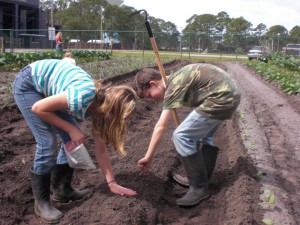
Planting Time
Did you know that something as simple as a garden can help youth not only learn to love vegetables, but also improve their science scores? Fifth-graders at Port St. Joe and Wewahitchka Elementary Schools experienced the benefits of gardening this year through the 4-H Seed to Plate Program. This program teaches youth how to plant, maintain, and harvest a vegetable garden, and is part of the science curriculum taught by 5th grade teachers.
Before the 130 students ever stepped foot in the garden they spent class time discussing the act of planting, the role that bees play in pollination and took a field trip to the North Florida Research and Education Center for 4-H Ag Adventures Day. This program is under the direction of Gulf County Extension Director Roy Lee Carter. The garden program is also supplemented with nutritional and food safety programs taught by Gulf County 4-H/Family & Consumer Science Agent, Melanie Taylor and Family Nutrition Program Assistant, Kay Freeman.
Carter said that the fifth grade is the ideal age level to learn gardening because the students are able to retain what they learn, and apply their new skills at home. The program is part of the science classes taught by the fifth-grade teachers each year. David and Sally Beyl have been volunteers with the program for the last seven years. Both are Master Gardeners who trained at the University of Florida for 12 weeks and contribute more than 50 hours of horticulture-related volunteer work each year.
“The students love it,” said David Beyl. “You can tell that they enjoy the experience.”
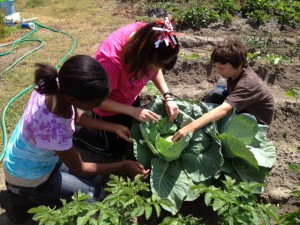
Harvest Time
A portion of what grows in the gardens was donated by Bonnie Plants in Alabama, the Florida Farm to School program, and the University of Florida’s Institute of Food and Agricultural Sciences. The Farm to School Partnership (administered by IFAS) works with local farmers to improve the supply of fresh produce to schools. Cabbage, lettuce, strawberries, potatoes, carrots, onions, eggplant, watermelon, beans, peppers, squash, sugarcane and various herbs made up this year’s garden with produce grown in-ground and in pots. “We use pots to show the students that even if you don’t have room for a garden, you can still have a garden,” Beyl said. In small groups, students learned how to plant seeds, rake, fertilize, cultivate, and harvest. Students even took home cabbages, carrots and potatoes to prepare and share with their families. Those who had an interest in starting their own gardens were given seeds to plant at home.
The highlight of the program is a luncheon prepared by cafeteria staff with produce grown by students. Everything the students munched on came from the garden they spent eight months cultivating. Both school principals are supportive and find this hands-on opportunity a great addition to the science program. This 4-H and public school collaboration is a very successful, educational and fun-filled learning experience.
If you have a green thumb, consider going “totally green” as a 4-H gardening volunteer or Master Gardener. 4-H needs caring adults like you to share their knowledge and passion for gardening with the next generation. Through the 4-H gardening project, youth not only learn gardening knowledge and skills, they also learn responsibility, teamwork, and other life skills that will help them grow up to be compassionate and competent citizens. To get involved, contact your local UF IFAS Extension Office, or visit http://florida4h.org./volunteers.
Your opinion matters! Please provide feedback on this short survey to help us improve our blog: https://ufl.qualtrics.com/SE/?SID=SV_3gtLKjqia3F75QN.
by Melanie Taylor | Jul 9, 2014

4-Hers still enjoy swimming and kayaking in the Choctawhatchee Bay. Photo provided by Jackson County 4-H.
Summer is here, and for most 4-H families, that means camp is on the horizon. If this will be your child’s first summer camp experience, you and your child both may have some camp anxieties. But never fear! Here are some simple steps you can take to prepare your camper (and yourself) for camp:
Preparing Campers:
• Plan several sleep overs before the week of camp arrives. Resist the urge to pack their bags for them or to check on them while there. If they have a cell phone, have them leave it at home. This is a good way to practice not having direct or constant contact.
• Encourage them to write a letter to someone (maybe you) while at camp. You will be so excited when you receive a letter from camp! Be sure to include envelopes, addresses, stamps, paper, and a pen in their luggage.
• Gear up physically. If you have purchased new tennis shoes, break them in with a few long walks, so the blisters don’t have to happen at camp.
• Especially for teenagers, have them take a mini-vacation from their electronic devices. A couple of hours or a weekend.
• Have them write a statement for their social media pages. “Peace out Facebook, I will be at camp for the next week. Check in with you when I get back.” Or something similar.
• Have them write down their goals for camp. So they can mentally prepare themselves for what they hope to do and see.
• Make a homesick plan:
1. Homesickness isn’t entirely bad. It’s great to love your home. It’s sometimes part of the process, and it’s a confidence booster when a camper gets through it.
2. Make a happy place plan and write it down. This is an amazing opportunity to learn a life skill. Today’s youth go to technology to escape, and studies show this increases their stress. Some ideas might be: taking 10 deep breaths, traveling to a happy place in your mind, packing a certain stuffed animal, or tossing a football. They are capable of this independence.
3. Your plan should NOT be, “Give it a couple of days and if you don’t like it, we will come get you.” This will set them up to give it a couple of days and knock the confidence right out of them.
4. Let your camper know what to expect with correspondence. You don’t need to write every day, but let them know what to expect.
Parents:
• You are giving your child an incredible gift. I cannot promise you that they will not lose some socks, that they will love every meal or activity, or that they will adore every counselor. But you are preparing them for college and beyond; you are giving them the freedom to gain confidence, independence, and leadership skills; and you are instilling in them that they can do it.
• What do YOU want to do during their time at camp? Plan a vacation for a later time, time to organize, time to have one-on-one time with your other children, or some “date nights” with your spouse or friends.
• If you have apprehensions, work to resolve them. If you are worried that your camper is not going to know anyone, set up a pre-camp get-together. If you are worried about your camper’s medical needs, become friendly with the camp staff. If you are anxious about their food allergies, talk to the camp’s director. Make a camper-sick plan for yourself. Make sure there is only excitement and optimism coming from you, and share your anxiety with another adult.
• Pack self-addressed envelopes in their luggage.
• Whether they are flying or driving, refrain from crying your eyes out until they cannot see you. Take a deep breath, trust, and remind yourself that you are giving them an awesome gift.
And, what is this gift everyone is talking about? At camp, they will be part of a community all their own. They will become emotionally attached to handmade rope bracelets on their wrist, and have a song for any occasion on cue, and maybe even forget they need to shower, and think sunscreen is just a normal daily moisturizing technique. They will learn to do things on their own, and they’ll learn to rely on others. They will learn how to survive on their own for a week or two, and they’ll learn how to help each other through it.
They may even grow up on summers away from TV, and forget Facebook exists. They will relish in the joy of sleeping in cabins, swatting mosquitoes at campfire, and swimming every day. They will savor the feeling of pushing water behind them with a paddle and the whoosh of air behind the tail of an arrow as they fire. They’ll forget about appearances, relish tan lines, and recognize the beauty of a smile over anything else.
So send your kids to camp. Send them so they’ll learn to set tables and make beds and wake early. Send them so they’ll know how to be a leader, paddle a kayak, weave a bracelet, and sing as loud as they can. Send your kids to camp so they’ll learn to love themselves and learn to love others. Send your kids to camp because they’ll realize who they are, or who they want to be. And, prepare yourselves for a year of camp stories, and for a flurry of songs. Prepare to learn names of kids you’ve never met. And for your kids to have a need for sunshine, a need for campfires, and companionship. They will be forever grateful for your awesome gift of summer camp.
Source:
American Camping Association, Inc. (http://www.acacamps.org)
by Melanie Taylor | Nov 22, 2013
As the autumn temperatures continue to fall, and we fill our days and evenings with more time outside, many of us yearn to enjoy the natural beauties of the environment without the humidity, extreme heat, and summer insects. During the activity portion of each 4-H Club meeting is a great time to explore and create using the natural resources around us. The purpose of these nature projects is to develop an appreciation for our environment. Conservation can only truly take place once we have recognized the natural beauty and wonder that surrounds us. These projects are generally easy to do, and kids can work on them together if they wish. And, there are more challenging projects for the older 4-H youth.
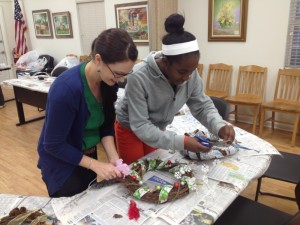
Gulf County adult 4-H Club leader assists a 4-Her on the finishing
touches of her grapevine wreath.
The Gulf County 4-H Craft Club members recently made their own grapevine wreaths and decorated them in their own creative ways.
Materials:
- vine
- pruners
- ribbon and a variety of decorating supplies (pinecones, twigs, leaves, glitter, character cut-outs, floral decorations, miniature birds, etc.)
- hot glue and glue gun
- pipe cleaners (to make a hook for hanging)
Directions:
1. Be sure to begin by finding a large location that can get dirty. The vines drop lots of debris. Find an abundance of firm, but bendable grape vines, gathering and untangling the vine pieces. When they have been tamed into a bundle (thickness is based on individual preference) that is manageable, form the vine into a circular shape on a large surface. Using a few thick strands of vine, begin to wind around the bundle, tucking the end of the vine in. (Note: if natural vines are not available, premade wreaths may be purchased at any craft store at a minimal cost.)
2. Continue to wind and secure the entire wreath. When the end meets the beginning, knit the vine ends together and continue to wind the outer vines to secure, overlapping the starting point. Tuck in any loose ends.
3. Set the wreath somewhere to dry and take shape. Preferably in a warm, sunny location. They will dry much faster this way. (If the kids will be making their own vine wreaths, and not using a pre-purchased one from a craft store, the wreath will need to be made days ahead of the decorating to give it time to dry properly.)
4. Now, it’s time to decorate. Let the kids be imaginative and create their own unique wreath to match their likes and personality. They can experiment by placing the items in different locations on the wreath. Once their decorating decisions are made use the hot glue to secure the items, ribbons, etc.
5. Do not forget to form a loop with a short piece of pipe cleaner to make a hook on the back of the wreath to hang it from.
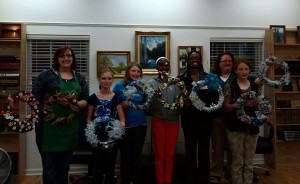
4-H Club members showcase their grapevine wreaths
Now, the wreaths can be taken home and enjoyed by all. Be sure to remember that time spent in nature is calming and refreshing to the human mind. So, as the weather becomes more tolerable here in Florida be sure to take time for yourself and to show youth the importance of natural exploration and creativity.
by Melanie Taylor | Jul 19, 2013
From the sand to the ocean, camp to the pool, water parks to the playground – summer usually means high-energy for kids enjoying time off from school. It’s a good idea to keep on hand a stash of cooling, nutritious snacks to satisfy ferocious appetites and picky palates.
One such snack for high energy kids is called BANANA SUSHI… Sushi is a Japanese food consisting of cooked rice, combined with other ingredients, usually raw fish or other seafood. Sushi is unique based on the preparation method and how it’s rolled up and sliced into bite size pieces. This is a unique teaching opportunity to discuss the Japanese culture and its different style of foods and eating methods. When you use this recipe, explain to the kids they will be making their own fun and tasty version of Sushi using bananas.
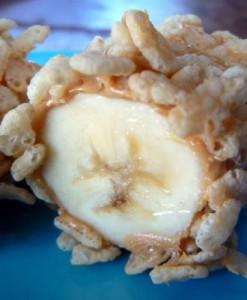
Banana Sushi
Prep Time: 5 minutes
Total Time: 5 minutes
Ingredients:
Banana, peanut butter, rice krispies cereal
Directions:
- Coat a banana with peanut butter. (For a cool treat on an especially hot day freeze the banana several hours before preparing.)
- Roll in rice krispies cereal.
- Slice into bite size pieces (like sushi).
- Eat and Enjoy!
- Encourage the kids to use chopsticks and to learn more about Japanese eating utensils.
Here are some more healthy and refreshing DIY treats that kids of all ages can prepare on their own or in group settings such as day camps and 4-H club meetings:
•Make your own trail mix with a combination of nuts, dried fruit, dark chocolate chips, and cereal pieces. Try a selection of several healthy cereals, pretzels, nuts, and crackers.
•Dried fruit – banana chips, mango, and apple, papaya, pear, or peach slices.
•Plain popcorn sprinkled with Parmesan cheese or flavorful spices.
•Baked pita or bagel chips dipped in cool, refreshing hummus.
•Skewer cubes of firm cheese (cheddar, Swiss, Monterey Jack), alternated with chunks of fresh summer fruits.
•Fresh fruit salad – Cut up apples, pineapple, bananas, oranges, and berries or any fresh, in-season fruits. Throw in dried cranberries or raisins, and sunflower seeds or slivered almonds. Top with a dollop of yogurt.
•Berry parfaits – Layer fresh berries with granola and yogurt or freshly whipped cream.
Of course, as you make theses treats with your 4-Hers be sure to incorporate the importance of their nutritional value to their daily intake based on the current MyPlate recommendation. You can find more kid-friendly information on MyPlate at http://www.choosemyplate.gov.






